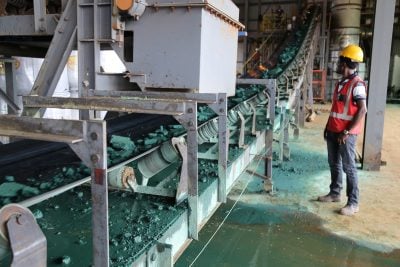In the inky blackness of night over Odesa you can hear them flying. That unmistakable buzz of a motorcycle engine powering a set of wings and a payload of explosives that make up a $50,000 deadly drone. Odesa, the grain exporting hub on the Black Sea, is one of cash-strapped Ukraine’s last hopes for hard currency, without which its war effort could founder.
The city is also the front line in this war of attrition since the full-scale Russian invasion more than two years ago. With Russia’s Black Sea fleet forced back over the horizon, the drones are a cheap way to sustain attack and spread fear among civilians. More than 10,000 have already lost their lives in Ukraine.
Russian forces are dug in around 100 kilometres away. Most nights drones come in groups of 10, sometimes 20, sending Ukrainians scuttling from their beds to the air raid shelters. Operators guide them in using GPS systems. Lately, the Russians have taken to painting the drones black to make them harder to pick out in the night sky. “It took them two years to work that out – really?” says a cynical Ukrainian journalist in Odesa.
Waiting for them along the Odesa coast are at least four staggered lines of ancient machine guns mounted on the backs of Toyota Hi-Lux vehicles. They shoot nearly all of the drones into balls of fire.
The price of missing is high. I saw the sickening aftermath of a drone strike in Odesa on 3 March. One slammed into a block of flats in the dock-workers’ dormitory suburb of Kuravkove while its occupants slept. Rescuers sweated for hours to dig out 12 lifeless bodies, including five children, as hundreds of neighbours watched in awful aching silence. One was a mother clutching her three-month-old baby to her chest.
Why not use Patriot missiles to be sure of destroying these drones? The authorities reply that the machine gun bullets cost little; a Patriot costs more than half a million dollars to fire. The missiles stand by just in case a fighter-bomber passes over Odesa.
Waging a cut-price war
This cut-price war is at the heart of Ukraine’s problem: it wants to fight on to keep its independence, but is running out of the men, money and munitions to do so.
Horror stories seep back from the front line in the east where the Russians fire 80 shells a day, but Ukrainian forces can muster far too few in reply. Reports say that Ukrainian officers instruct their gun crews to hang fire until more Russian troops venture into their sights – so the scarce shells are not wasted.
This is why Ukraine is trying to garner billions of dollars in aid and weapons from NATO countries. But it takes months for a trained Ukrainian soldier to learn how to use a British tank or a French missile. And trained soldiers are also in short supply with 31,000 dead.
One of the most powerful men in the land has the job of gathering support and weapons. Mykhailo Podolyak is the most senior advisor to President Volodymyr Zelensky. Dressed in chinos and a black hoodie, he looks more like a college lecturer on the night we meet in Kyiv.
He lays bare his country’s needs in a shopping list: 200,000 artillery shells per month; 50,000 to 100,000 drones and 200 to 300 Storm Shadow long-distance missiles, for starters.
“For Putin, the war is the only way he can stay in power and he wants to dominate in Europe,” he says through an interpreter. Podolyak wants Africa to take a firmer hand in international affairs regarding the conflict. He alludes to a recent African National Congress visit to Moscow, from South Africa.
“I would like Africa to speak with a louder voice in diplomatic negotiations…We want to see them come here to say things are not right!”
At least the Ukraine Navy can say it is doing some things right. It has forced the battered Russian Black Sea Fleet back more than 100 sea miles to give Odesa and its grain exports breathing space. It took the sinking of 45% of the Russian fleet to do so, including the flagship Moskvar – the first Russian warship to sink since World War Two.
“It is stalemate now. The Russian warships can’t destroy us, but on the other hand we can’t destroy them!” Lieutenant Commander Dmytro Pletenchuk, the spokesman for the Ukraine Navy, says with a smile at his offices in Odesa. But for how long?
Want to continue reading? Subscribe today.
You've read all your free articles for this month! Subscribe now to enjoy full access to our content.
Digital Monthly
£8.00 / month
Receive full unlimited access to our articles, opinions, podcasts and more.
Digital Yearly
£70.00 / year
Our best value offer - save £26 and gain access to all of our digital content for an entire year!


 Sign in with Google
Sign in with Google 




